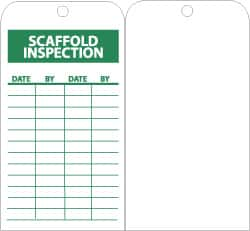


Scaffold components manufactured by different manufacturers are not allowed to be modified to make them fit together, unless a competent person determines that the resulting scaffold is structurally sound.Scaffold components manufactured by different manufacturers must not be intermixed, unless they fit together without being forced, and the scaffold's structural integrity is maintained.Scaffold with Improvised Components Fails Worker Dies How can you tell if these components possess sufficient structural integrity? This is the same jury-rigged scaffold as in Figure 4. Scaffolds shall be altered only under the supervision and direction of a competent person.No more than three employees should occupy suspension scaffolds designed for a working load of 750 pounds (non-mandatory).No more than two employees should occupy suspension scaffolds designed for a working load of 500 pounds (non-mandatory).Be secured against movement by tiebacks installed at right angles to the face of the building or structure ( 5 & 6), or by opposing angle tiebacks installed and secured to a structurally sound point of anchorage (structurally sound points of anchorage include structural members, but not vents, electrical conduit, or standpipes and other piping systems).Or 1½ times the stall capacity of the hoist.Rest on surfaces capable of supporting at least 4 times the load imposed on them by the scaffold operating at the greater of either :.All suspension scaffold support devices, such as outrigger beams, cornice hooks, and parapet clamps, must:.Or 2 times the stall load of the hoist.Each suspension rope, including connecting hardware, must be capable of supporting, without failure, at least 6 times the maximum intended load applied to that rope while the scaffold is operating at the greater of either :.Scaffolds and scaffold components must be capable of supporting, without failure, their own weight and at least 4 times their maximum intended load.įoreman Dies When Overloaded Scaffold Falls Counterweights must not be removed from an outrigger beam until the scaffold is disassembled.Counterweights must be secured by mechanical means to the outrigger beams (Figures 2 & 3) to prevent accidental displacement.Counterweights must not be made of flowable materials such as sand, gravel, and similar materials that can be easily dislocated.Masonry units, rolls of roofing felt, and other similar construction materials shall not be used as counterweights.Only items specifically designed as counterweights may be used to counterweight scaffold systems.Or a minimum of 1½ times the tipping moment imposed by the scaffold when it is operating at the stall load of the hoist, whichever is greater.At least 4 times the tipping moment imposed by the scaffold when it is operating at the rated load of the hoist.Counterweights used to balance adjustable suspension scaffolds must be capable of resisting :.Or bolts or other direct connections to the floor or deck.

Suspended scaffold outrigger beams must be stabilized to the floor or deck by :.Inadequate Counterweights Cause Two Deaths


 0 kommentar(er)
0 kommentar(er)
